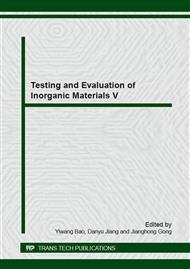p.159
p.165
p.169
p.173
p.179
p.183
p.189
p.193
p.198
Study of Evolution Rule of Aggregates in Ceramic Suspension
Abstract:
Using the micron alumina powder for the study, through the analysis of the ceramic suspension rheological, the generation and evolution and its mechanism of aggregates in the ceramic suspension were studied. The results showed that the number, size and intensity of aggregates will be effected by the gravitational potential or the barrier height between the particles in suspension as varying the process conditions. Generally, the formation of aggregates was corresponded to the interaction potential between particles, that is, the second potential well. Thus, their internal bonding strength is weak. In the flowing suspension, aggregates were meta-stability under shear forces, electrostatic repulsion and van der Waals potential. The variation of the aggregates was a reversible process as decomposition then reunion again.
Info:
Periodical:
Pages:
179-182
Citation:
Online since:
November 2014
Authors:
Keywords:
Price:
Сopyright:
© 2015 Trans Tech Publications Ltd. All Rights Reserved
Share:
Citation:


